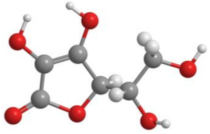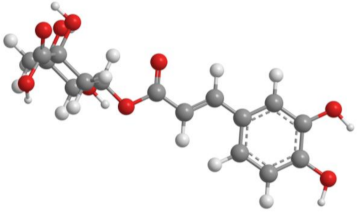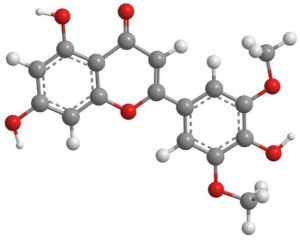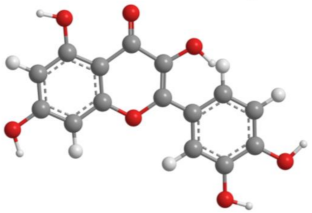Abstract
The inappropriate use of synthetic antibiotics has become a global public health problem. Therefore, the study of new alternatives for the treatment of infectious diseases is relevant and natural bioactive products are on the rise. This study conducted a scientific prospection of bioactive natural products with promising applications in the chemical control of microorganisms. A systematic review of the most recent articles was performed according to the following three steps: (i) eligibility assessment, (ii) screening, and (iii) inclusion of articles and information extraction. There has been an increase in the number of scientific publications on bioactive natural products for microbial control in the CAPES and SciELO databases (2001–2021). Seventeen relevant articles were included, most of which focused on extracts. Ascorbic acid, chlorogenic acid, chrysin, and quercetin were the most cited compounds. Natural products were shown to be effective in inhibiting more than 30 microorganisms. A discussion was presented on the research trends.
1. Introduction
Injudicious use of conventional synthetic antibiotics in the treatment of infectious diseases has become a global public health problem. Pathogenic microorganisms evolve by developing adaptation and resistance mechanisms, such as production of inactivating enzymes, decreased membrane permeability, and efflux pumps for antibiotics. Multidrug resistance has been reported in several clinically relevant bacteria, including Escherichia coli, Klebsiella pneumoniae, Pseudomonas aeruginosa, and Staphylococcus aureus [1,2,3].
The World Health Organization (WHO) monitors global trends in evidence-based healthcare and has supported the implementation (2014–2023) of traditional and complementary medicine strategies. Traditional and complementary medicine is an important health resource for modern therapy and in it might lie important solutions to the development and evolution of multidrug-resistant strains [4,5]. For instance, Brazil has a great diversity of medicinal plants widely investigated for scientific and technological applications and intensively used as herbal medicines [6,7].
Several chemical compounds can be produced and extracted from a single species [8,9]. Medicinal plants can be used to produce standardized extracts, essential oils, and purified phytochemicals with biological activities [10,11]. Bioactive natural products, which can be used separately or in combination, induce changes in membrane permeability or damage proteins and nucleic acids in microbial cells [12]. Studies have demonstrated that several bioactive natural products show effective antagonistic activity against foodborne pathogens and spoilage microorganisms [13,14].
This study aimed to conduct a scientific prospection and systematic review of promising bioactive natural products for chemical control of microorganisms. Two databases were selected and strategies were applied for the search, collection, and treatment of prospection data (2001–2021). Protocols were developed for the selection of the most recent articles and data extraction, comprising the following three steps: (i) eligibility assessment, (ii) screening, and (iii) article inclusion and information extraction. A discussion was presented on the main sources of extraction, importance of natural bioactive products, most cited bioactive natural compounds, microorganisms and inhibition effectiveness, and perspectives on research trends.
2. Results and Discussion
2.1. Scientific Prospecting of Data
The results of the searches carried out in CAPES and SciELO databases are presented in Table S1 (Supplementary Materials). The keywords with the highest quantitative contribution were (“essential oil” OR extract) AND antib* for the CAPES database and (“essential oil” OR extract) AND antimicr* for the SciELO database, both in English. Search strategies containing English keywords retrieved a larger number of articles, given the international nature of this language. From a total of 266,936 scientific articles retrieved, 256,780 were published in peer-reviewed journals indexed in the CAPES database. The CAPES database had a higher number of published articles in both languages, as expected, because this database also includes publications indexed by SciELO. Sample representativeness was the lowest when the keyword “fitoquímico” (phytochemical) was used as a descriptor in term 1, with a reduction in the number of retrieved papers according to the following order of descriptors in term 2: antimicr* > antib* > bactericidal > biocidal > “chemical agent”.
2.2. Annual Evolution of Studies (2001–2021)
The annual distribution (2001–2021) of articles retrieved from the CAPES database by using the keywords (“essential oil” OR extract) AND antib* is depicted in Figure 1. Initial and final cycles were defined as the first and last 5 completed years, respectively, of the study temporal range (21 years).
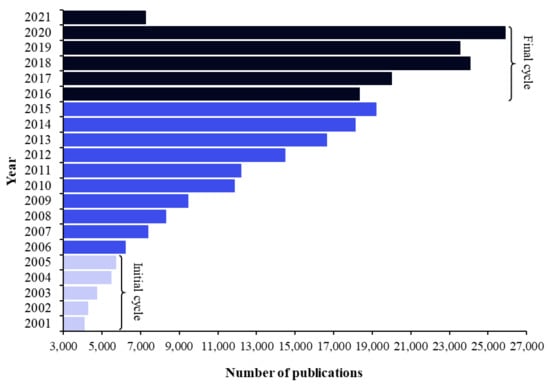
Figure 1.
Annual number of scientific publications identified in the CAPES database. The search strategy was (“essential oil” OR extract) AND antib*.
The number of publications in the CAPES database increased from 2001 to 2021. An increase in the number of studies in relation to the previous number occurred every year, except in 2016 (n = 18,329) and 2019 (n = 23,539). More than 20,000 articles were published in the last 5 completed years (final cycle). This number was at least four times higher than that in the initial cycle (2001–2005). It was estimated that more articles will be published in subsequent years than in previous years, given that, up to the first quarter of 2021, 7234 studies had been published. Thus, >26,000 articles on the use of bioactive natural products for microbial control are expected to be published in 2021. WHO’s incentive for countries to generate evidence-based policies and strategic plans for the use of medicinal plants might be related to the increase in research in recent years [4].
The annual distribution (2001–2021) of scientific articles indexed in the SciELO database, identified by the keywords (“essential oil” OR extract) AND antimicr*, is depicted in Figure 2.
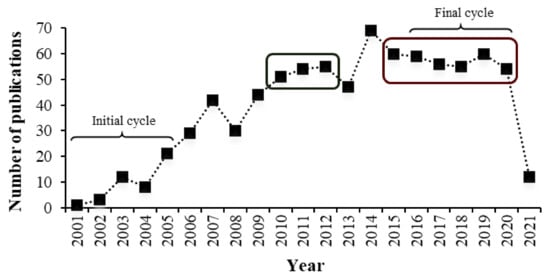
Figure 2.
Annual number of scientific publications identified in the SciELO database. The search strategy was (“essential oil” OR extract) AND antimicr*.
The number of publications in the SciELO database also increased over the past 21 years. In 2004, 2008, 2013, and 2015, there was a low number of publications compared with previous years. From 2015 to 2020, the number of publications remained constant (≈57), similar to that observed from 2010 to 2012 (≈53). The highest peak occurred in 2014, with 69 scientific articles. The final cycle (last 5 completed years) had about five times the number of publications than the initial cycle. It was estimated that the number of publications in 2021 would not surpass that of 2020, as only 12 articles had been published in the first quarter. The national scenario of disruptions and limitations imposed by the SARS-CoV-2/COVID-2019 pandemic might have hindered the annual evolution of experimental studies.
2.3. Ranking of Thematic Areas and Journals
Ranking of the thematic areas and journals according to the number of scientific articles published in CAPES and SciELO databases is presented in Table 1.

Table 1.
Ranking of thematic fields and journals with the highest number of publications on bioactive natural products for microbial control.
The thematic areas Chemistry (23.52%, n = 35,797), Engineering (16.71%, n = 25,428), and Bacteria (15.98%, n = 24,329) had the highest number of publications in the CAPES database. More specific areas, such as antibacterial agents, antibacterial activity, and antimicrobial agents, were also identified. The microorganisms E. coli and S. aureus ranked 5th and 10th, respectively, as thematic areas, suggesting that they are the major species investigated in inhibition tests with bioactive natural products. The journal Molecules had more than 5000 publications, representing about 70% of the total number of articles (n = 7846). The other journals with the highest number of publications on the subject were Journal of Applied Microbiology (6.93%, n = 517), Journal of Essential Oil-Bearing Plants (4.86%, n = 363), and Industrial Crops and Products (4.41%, n = 329).
Articles retrieved from SciELO were classified into the major thematic areas Agricultural Sciences (29.48%, n = 278), Health Sciences (26.30%, n = 248), and Biological Sciences (25.03%, n = 236). These thematic areas were comprehensive, with the global field of sciences accounting for over 800 publications. Articles can be classified into more than one area of publication or theme, generating duplicity of citations and variation in the number of themes. Of the scientific journals indexed in the SciELO database, Revista Brasileira de Pharmacognosia was the one with the highest number of publications on the subject (25.97%, n = 100), in agreement with the thematic area ranking 2nd (health sciences). The three journals with the largest numbers of scientific articles were discontinued from the SciELO database, namely Revista Brasileira de Pharmacognosia, Revista Brasileira de Plantas Medicinais, and Brazilian Journal of Microbiology. The scopes of the ranked journals are in accordance with the main thematic areas. All journals reported the impact factor, as identified in the 2019 Journal Citation Reports, with the exception of Revista Brasileira de Plantas Medicinais. Nevertheless, the impact factor was not directly proportional to the number of published articles.
2.4. Country of Origin of Journals
Figure 3 shows the number of publications retrieved from the SciELO database according to the country of origin of scientific journals.
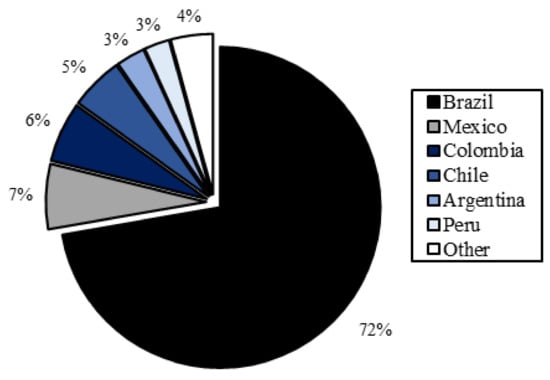
Figure 3.
Countries with the highest proportion of scientific publications on bioactive natural products for microbial control in the SciELO database. The search strategy was (“essential oil” OR extract) AND antimicr*.
A total of 6 countries had the highest number of publications, totaling 822 articles. Brazil accounted for 72% (n = 594) of the publications, which was expected, given that the SciELO database comprises a wide range of Brazilian scientific journals. Mexico, Colombia, Chile, Argentina, and Peru were the following major publishing countries, demonstrating the importance of research on bioactive natural products for microbial control in these countries. Only 4% (n = 35) of publications stemmed from other countries.
2.5. Relevant Recent Research
Initially, 822 records were identified using the advanced search table. In the first stage of selection, 66 articles were pre-selected, 22 of which were excluded. In the second stage (full-text reading), 27 articles were excluded. In the third stage, 17 relevant articles were selected. The information of interest was extracted, grouped, and presented in Table 2 and Figure S1 (Supplementary Materials).

Table 2.
Information extracted from relevant articles on bioactive natural products for microbial control.
2.6. Main Sources of Extraction
Bioactive natural products of plant origin predominated in the retrieved studies. Only two articles used an extraction source of animal origin (propolis) [25,27]. The other 15 studies investigated different botanical species, suggesting interest of the scientific community in identifying new potential bioproducts from a diversity of plant species. Most studies extracted compounds from leaves [5,16,17,18,19,20,21,28,29,30], followed by peels [15,17,29], aerial parts [22,23,26], stem [17,18], flower [18], and roots [24]. According to Yuan et al. [31], leaves provide higher essential oil yields than other plant parts.
2.7. Importance of Natural Bioactive Products
Extracts and essential oils were the most frequent keywords (Table S1, Supplementary Materials). Studies that used extracts predominated [15,17,18,19,20,21,22,24,25,26,27,29,30]. Plant extracts can be obtained by processes that concentrate the desired material into a matrix of greater chemical complexity [32]. The low extraction yield (<1%) of essential oils may be a limiting factor, as argued by Wajs-Bonikowska et al. [33]. Ethanol and water were the major solvents for obtaining bioactive natural products. Hydrodistillation was mainly used for essential oil extraction [5,16,23,28] and maceration for extract preparation [17,20,22,24,25,26,29,30].
2.8. Most Cited Bioactive Natural Compounds
Bioactive products were categorized into classes, subclasses, and specific compounds. A higher frequency of flavonoids and terpenoids was observed. Sesquiterpenes and caryophyllenes were the most frequently identified subclasses of terpenes. The 3D structure and characteristics of the most cited compounds are shown in Table 3. Ascorbic acid, chlorogenic acid, chrysin, and quercetin were associated with various bioactive properties, such as antioxidant, anti-inflammatory, antiviral, antiallergic, hepatoprotective, neuroprotective, antiasthmatic, antidiabetic, and antidepressant properties [34,35,36,37]. It is important to note that the identification of some constituents may be limited by the analytical method used. Some identification techniques depend on analytical standards and may not be able to screen all major compounds of extracts and essential oils. Therefore, quantified constituents may or may not be the most important compounds in terms of composition and bioactivity.

Table 3.
Bioactive compounds identified in articles included in this review.
2.9. Microorganisms and Inhibition Effectiveness
Inhibition effectiveness was tested against more than 30 microorganisms. Cunha et al. [20] found that the foliar extract of Senna rugosa was not effective in inhibiting Aspergillus niger ATCC 10535, Candida albicans ATCC 90028, Klebsiella oxytoca ATCC 49131, Penicillium expansum ATCC 1117, or Salmonella Typhimurium ATCC 14028. The other relevant articles reported partial or total efficacy of bioactive natural products, demonstrating the high potential of biocompounds for the control of microorganisms. Efficacy in inhibition tests is directly associated with biocompound concentration, treatment time, and microbial resistance. Various studies have carried out tests against multi-drug resistant strains, such as S. aureus (Gram-positive) and E. coli (Gram-negative), explaining the high rank of these thematic areas with regard to the number of published studies (Table 1). C. albicans was the most studied fungus [15,17,19,20,21,26,27].
2.10. Perspectives on Research Trends
Relevant articles demonstrated the promising action of bioactive natural products in microbial control. The following aspects should be considered and further explored:
- Inclusion of extract or essential oil in food matrices may contribute to the bioactivity, bioavailability, and bioaccessibility of bioactive compounds of interest; compounds can be introduced into matrices via alternative techniques, such as marinating, sprinkling, soaking, and brushing.
- In vitro and in vivo results are important to substantiate claims of the functional properties of bioactive ingredients in foods, contributing to healthiness and ensuring consumers’ rights to information.
- Extraction of bioactive compounds and development of bioactive natural products from food industry by-products has high scientific, technological, socioeconomic, and environmental appeal; these materials can also be used in active and intelligent packaging.
- Reports of the direct application of purified phytochemicals and bioactive natural dyes/pigments for food enrichment are still scarce; viable systems may be developed to strengthen the metabolic activity of beneficial microorganisms, whether added, natural, or autochthonous (acid-lactic bacteria and/or yeasts, probiotic or not).
- Compound protection technologies, such as microencapsulation, nanoencapsulation, and nanoemulsion, can optimize bioactivity, bioavailability, and bioaccessibility, thereby enhancing product stability and ease of transport, storage, and distribution.
3. Material and Methods
This study used a mixed method, consisting of scientific prospecting followed by a systematic review of the literature (Figure 4) based on the Preferred Reporting Items for Systematic Reviews and Meta-Analyses (PRISMA) [38], including procedures adapted from the work of Melo et al. [39] and Bezerra and Pinheiro [40].
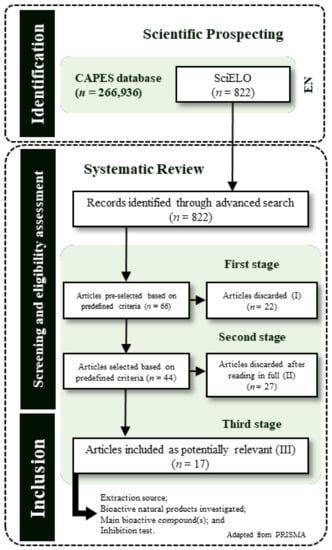
Figure 4.
Flowchart of the mixed method used to search the literature for relevant articles on bioactive natural products for microbial control. En, articles written in English.
3.1. Scientific Prospecting of Data
3.1.1. Sources of Information
The following two electronic databases were searched: the CAPES database (Portal de Periódicos CAPES of the Brazilian Federal Agency for Support and Evaluation of Graduate Education), which provides democratic and easy access to several databases of high scientific relevance [41], and the Scientific Electronic Library Online (SciELO) database, which is the main cooperative electronic portal for open-access scientific journals in Latin America [42]. No contact was made with the authors to identify additional studies.
3.1.2. Search Strategies
Searches for articles on bioactive natural products for microbial control, written in Portuguese or English, were carried out in the advanced search tab of each database. Truncated terms, quotation marks, and Boolean operators were used to construct the search strategy, according to the particularities, supported characters, and instructions provided by the databases. Conference proceedings, technical books, monographs, dissertations, and theses were excluded by applying specific filters. Searches were performed between 27 April and 6 May 2021. Time of publication was restricted to the past 21 years. The combination of keywords and descriptors, presented in detail in Table S2 (Supplementary Materials), can be summarized as follows: bioactiv* AND (antib*; antimicr*; bactericidal; biocidal; “chemical agent”), phenol* AND (antib*; antimicr*; bactericidal; biocidal; “chemical agent”), phytochemical AND (antib*; antimicr*; bactericidal; biocidal; “chemical agent”); and “essential oil” OR extract AND (antib*; antimicr*; bactericidal; biocidal; “chemical agent”).
3.1.3. Data Processing
The keyword and language with the highest quantitative contributions were used for data processing. The data were tabulated and analyzed in terms of the following quantitative variables: annual number of publications (2001–2021), ranking of thematic areas, journals with the highest number of articles published, and country of origin of journals (SciELO database only). The results are presented in tables or figures, constructed using Microsoft® Excel 2013.
3.2. Systematic Review Protocol
Publications were identified and selected using the keyword and language with the highest quantitative contribution in the SciELO database. A protocol was used to select the most recent articles and extract the data, consisting of the following three steps: (i) eligibility assessment, (ii) screening, and (iii) article inclusion and extraction of information. The risk of bias was not assessed. Eligibility was defined as meeting the totality of the following criteria (yes = 100%):
- Was the scientific paper published between 2020 and the current date (2021)?
- Can the overall objective of the research be easily identified?
- Is the source of bioactive natural products specified?
- Was the bioactive natural product used in the form of an extract or essential oil?
- Is the preparation procedure described clearly and in detail?
- Has at least one compound responsible for biological activity (rather than a group or class) been identified using adequate analytical techniques?
- Were inhibition tests performed against at least one specific microorganism?
- Is the analytical method or technique described clearly and in detail?
- Is the effectiveness of microbial inhibition reported?
- Are the results and/or conclusions aligned with the overall objectives of the study?
In the first step, articles that did not meet the eligibility criteria were excluded. In the second step, articles were screened by two reviewers, who read the texts in full in a double-blind system and selected relevant articles. Disagreements were discussed until consensus was reached and the opinion of a third reviewer was requested for final decision making. In the third step, articles were included on the basis of shared decisions, and the following information was extracted: natural source of bioactive products (species and organ), type of bioactive natural product (extract or essential oil, solvent, and extraction method), main bioactive compounds and major components of the natural product, and inhibition test (microorganism species and efficacy assessment).
Efficacy was categorized as yes, partial, or no. Compounds were classified as effective (yes) when they achieved complete efficacy at a given concentration and/or during a given incubation time; as partial when they showed limited efficacy against at least one type of microorganism, regardless of the concentration and/or incubation time tested; and as ineffective (no) when they did not achieve significant results at any concentration or incubation time against any microorganism. Extracted data were organized in tables and/or figures and analyzed in terms of main sources of extraction, importance of natural bioactive products, most cited bioactive natural compounds, microorganisms and inhibition effectiveness, and perspectives on research trends.
4. Conclusions
The research trends indicated that more than 26,000 articles on the potential of bioactive natural products for chemical control of microorganisms will be published in the coming years in journals indexed by CAPES. E. coli and S. aureus were the main species investigated in inhibition tests with bioactive natural products. In the SciELO database, more than 800 articles categorized into the field of Sciences were identified, and the Revista Brasileira de Pharmacognosia was the major publishing journal, with 100 publications (25.97%). Scientific interest in the subject has increased in Brazil and in countries such as Mexico, Colombia, Chile, Argentina, and Peru.
The major extraction sources were of plant origin, mainly leaves, peels, and aerial parts. The importance of extracts and essential oils was evidenced. These materials were obtained mainly by maceration and hydrodistillation, respectively, with ethanol and water as solvents. Ascorbic acid, chlorogenic acid, chrysin, and quercetin were the most cited bioactive compounds. Partial and/or total inhibition of at least 30 different microorganisms by bioactive natural products was identified, being related to compound concentration, treatment time, and microbial resistance. Relevant articles demonstrated the promising action of bioactive natural products in the chemical control of microorganisms. Future trends were discussed.
Supplementary Materials
The following are available online at https://www.mdpi.com/article/10.3390/molecules27185917/s1, Table S1. Results of the keyword searches for articles in Portuguese (PT) and English (EN); Table S2. List of keywords used to search for scientific articles on bioactive natural products for 15 microbial control in Portuguese and English. Figure S1. Graphical abstract of scientific information on bioactive natural products for microbial control.
Author Contributions
Conceptualization, B.F.F. and C.M.d.A.; methodology, A.B.S.d.L. and A.S.S.; software, A.d.S.A.; investigation, M.T.C.; resources, E.M. and P.A.M.d.F.; writing—original draft preparation, I.M.A. and E.M.; supervision, H.D.M.C.; project administration, P.W. and H.D.M.C. All authors have read and agreed to the published version of the manuscript.
Funding
This research received no external funding.
Institutional Review Board Statement
Not applicable.
Informed Consent Statement
Not applicable.
Conflicts of Interest
The authors declare no conflict of interest.
References
- Cheng, G.; Ning, J.; Ahmed, S.; Huang, J.; Ullah, R.; An, B.; Hao, H.; Dai, M.; Huang, L.; Wang, X.; et al. Selection and dissemination of antimicrobial resistance in Agri-food production. Antimicrob. Resist. Infect. Control. 2019, 8, 1–13. [Google Scholar] [CrossRef]
- Falleh, H.; Ben Jemaa, M.; Djebali, K.; Abid, S.; Saada, M.; Ksouri, R. Application of the mixture design for optimum antimicrobial activity: Combined treatment of Syzygium aromaticum, Cinnamomum zeylanicum, Myrtus communis, and Lavandula stoechas essential oils against Escherichia coli. J. Food Process. Preserv. 2019, 43, e14257. [Google Scholar] [CrossRef]
- Qiu, Y.; Xu, D.; Xia, X.; Zhang, K.; Aadil, R.M.; Batool, Z.; Wang, J. Five major two components systems of Staphylococcus aureus for adaptation in diverse hostile environment. Microb. Pathog. 2021, 159, 105119. [Google Scholar] [CrossRef] [PubMed]
- World Health Organization (WHO). Global Report on Traditional and Complementary Medicine 2019. Available online: https://www.who.int/publications/i/item/978924151536 (accessed on 9 September 2022).
- Pacheco, L.A.; Ethur, E.M.; Sheibel, T.; Buhl, B.; Weber, A.C.; Kauffmann, C.; Marchi, M.I.; Freitas, E.M.; Hoehne, L. Chemical characterization and antimicrobial activity of Campomanesia aurea against three strains of Listeria monocytogenes. Braz. J. Biol. 2021, 81, 69–76. [Google Scholar] [CrossRef] [PubMed]
- Pio, I.D.S.L.; Lavor, A.L.; Damasceno, C.M.D.; Menezes, P.M.N.; Silva, F.S.; Maia, G.L.A. Traditional knowledge and uses of medicinal plants by the inhabitants of the islands of the são francisco river, Brazil and preliminary analysis of Rhaphiodon echinus (Lamiaceae). Braz. J. Biol. 2019, 79, 87–99. [Google Scholar] [CrossRef] [PubMed]
- Mendonça, L.A.B.M.; Matias, R.; Zanella, D.F.P.; Porto, K.R.A.; Guilhermino, J.F.; Moreira, D.L.; Roel, A.R.; Pott, A.; Carvalho, C.M.E. Toxicity and phytochemistry of eight species used in the traditional medicine of sul-mato-grossense, Brazil. Braz. J. Biol. 2020, 80, 574–581. [Google Scholar] [CrossRef]
- Emre Kurşat, M.; Yilmaz Erecevi, P. Chemical compositions, radical scavenging capacities and antimicrobial activities in seeds of Satureja hortensis L. and Mentha spicata L. subsp. spicata from turkey. Braz. J. Biol. 2021, 81, 144–153. [Google Scholar] [CrossRef]
- Basaglia, R.R.; Pizato, S.; Santiago, N.G.; Maciel de Almeida, M.M.; Pinedo, R.A.; Cortez-Vega, W.R. Effect of edible chitosan and cinnamon essential oil coatings on the shelf life of minimally processed pineapple (Smooth cayenne). Food Biosci. 2021, 41, 100966. [Google Scholar] [CrossRef]
- Dar, K.K.; Ali, S.; Ejaz, M.; Nasreen, S.; Ashraf, N.; Gillani, S.F.; Shafi, N.; Safeer, S.; Khan, M.A.; Andleeb, S.; et al. In vivo induction of hepatocellular carcinoma by diethylnitrosoamine and pharmacological intervention in Balb C mice using Bergenia ciliata extracts. Braz. J. Biol. 2019, 79, 629–638. [Google Scholar] [CrossRef]
- Pontes, F.C.; Abdalla, V.C.P.; Imatomi, M.; Fuentes, L.F.G.; Gualtieri, S.C.J. Antifungal and antioxidant activities of mature leaves of Myrcia splendens (Sw.) DC. Braz. J. Biol. 2019, 79, 127–132. [Google Scholar] [CrossRef] [PubMed] [Green Version]
- Patiño Bello, D.P.; Pérez Acevedo, L.V.; Torres Caycedo, M.I.; Rosas Leal, D.A.; Di Filippo Iriarte, G. Uso de biocidas y mecanismos de respuesta bacteriana. Rev. Cuba. De Investig. Bioméd. 2018, 37, 1–17. [Google Scholar]
- Araújo, J.S.F.; de Souza, E.L.; Oliveira, J.R.; Gomes, A.C.A.; Kotzebue, L.R.V.; da Silva Agostini, D.L.; de Oliveira, D.L.V.; Mazzetto, S.E.; da Silva, A.L.; Cavalcanti, M.T. Microencapsulation of sweet orange essential oil (Citrus aurantium var. dulcis) by liophylization using maltodextrin and maltodextrin/gelatin mixtures: Preparation, characterization, antimicrobial and antioxidant activities. Int. J. Biol. Macromol. 2020, 143, 991–999. [Google Scholar] [CrossRef] [PubMed]
- Yostawonkul, J.; Nittayasut, N.; Phasuk, A.; Junchay, R.; Boonrungsiman, S.; Temisak, S.; Kongsema, M.; Phoolcharoen, W.; Yata, T. Nano/microstructured hybrid composite particles containing cinnamon oil as an antibiotic alternative against food-borne pathogens. J. Food Eng. 2021, 290, 110209. [Google Scholar] [CrossRef]
- Aguilar-Méndez, M.A.; Campos-Arias, M.P.; Quiroz-Reyes, C.N.; Ronquillo-De Jesús, E.; Cruz-Hernández, M.A. Fruit peels as sources of bioactive compounds with antioxidant and antimicrobial properties. Rev. Fac. De Cienc. Agrar. UNCuyo 2020, 52, 360–371. [Google Scholar]
- Alves, M.C.C.; Chaves, D.S.A.; Benevenuto, B.R.; DEFARIASBO; Coelho, S.M.O.; Ferreira, T.P.; Pereira, G.A.; Dos Santos, G.C.; Moreira, L.O.; De Freitas, J.P.; et al. Chitosan gels for buccal delivery of Schinus molle L. Essential oil in dogs: Characterization and antimicrobial activity in vitro. An. Acad. Bras. Ciênc. 2020, 92, e20200562. [Google Scholar] [CrossRef] [PubMed]
- Andrade, E.M.J.; Teixeira, J.S.; Silva, D.K.C.; dos Santos, T.B.; Korn, M.G.A.; Brandão, H.N.; Ferraz, C.; Meira, C.; Soares, M.; Guimarães, E.; et al. Phytochemical Analysis, multi-element composition and biological activities of extracts and Lupenone from Albizia inundata (Mart.) Barneby & J.W.Grimes. J. Braz. Chem. Soc. 2020, 31, 1825–1837. [Google Scholar] [CrossRef]
- Barragán, N.A.; Pita-Ospina, E.F.; Sánchez Mora, R.M.; Giraldo Quintero, S.E.; Bernal Lizarazú, M.C. Actividad in vitro de los extractos etanólicos de Lantana camara L., Petiveria alliacea L. y Lippia dulcis T. frente a bacterias patógenas. Nova 2020, 18, 53–71. [Google Scholar] [CrossRef]
- Cerdeira, C.D.; Da Silva, J.J.; RNetto, M.F.; GBoriollo, M.F.; IMoraes, G.O.; Santos, G.B.; Dos Reis, L.F.C.; Brigagão, M.R.P.L. Talinum paniculatum: A plant with antifungal potential mitigates fluconazole-induced oxidative damage-mediated growth inhibition of Candida albicans. Rev. Colomb. Cienc. Químico-Farm. 2020, 49, 401–431. [Google Scholar] [CrossRef]
- Cunha, L.F.; Costa, C.M.; Barroso, P.R.; Kato, K.C.; De Oliveira, F.; Victor, C.; Grael, C.F.F.; Gregorio, L.E.; Campos, F.F.; De Oliveira, P.M.; et al. Phytochemical screening and biological assays of ethanolic leaf extract of Senna rugosa. Rodriguésia 2020, 7, 2–15. [Google Scholar] [CrossRef]
- Ferrari, D.O.; Zanella, L.; Lund, R.G.; Júnior, W.A.R.; Rodrigues-Junior, S.A. Hydroalcoholic Extract of Eugenia uniflora as denture disinfectant: Antimicrobial activity and effect on the physical properties of Polymethylmethacrylate. Braz. Arch Biol. Technol. 2020, 63, 1–10. [Google Scholar] [CrossRef]
- González-Alamilla, E.; Rivas-Jacobo, M.; Sosa-Gutiérrez, C.; Delgadillo-Ruiz, L.; Valladares-Carranza, B.; Rosenfeld-Miranda, C.; Zaragoza-Bastida, A.; Rivero-Pérez, N. Antibacterial effect of the methanol extract of Salix babylonica against important bacteria in public health. Abanico Vet. 2020, 10, 1–11. [Google Scholar]
- Nogueira Sobrinho, A.C.; Morais, S.M.; Sousa, E.B.; Albuquerque, M.R.J.R.; Santos, H.S.; Cavalcante, C.S.P.; De Sousa, H.A.; Fontenelle, R.O.D.S. Antifungal and antioxidant activities of Vernonia chalybaea Mart. ex DC. essential oil and their major constituent β-caryophyllene. Braz. Arch Biol. Technol. 2020, 63, e20190177. [Google Scholar] [CrossRef]
- Pérez-Pérez, J.U.; Guerra-Ramírez, D.; Reyes-Trejo, B.; Cuevas-Sánchez, J.A.; Guerra-Ramírez, P. Actividad antimicrobiana in vitro de extractos de Jatropha dioica Seseé contra bacterias fitopatógenas de tomate. Polibotánica 2020, 49, 125–133. [Google Scholar] [CrossRef]
- Sánchez, R.D.V.; Benavidez, E.M.; Hernández, J.; Urrutia, G.R.T.; Escalante, A.S. Effect of physicochemical properties and phenolic compounds of bifloral propolis on antioxidant and antimicrobial capacity. Nova Sci. 2020, 12, 1–25. [Google Scholar] [CrossRef]
- Taşkın, T.; Gezmiş, T.; Çam, M.E.; Taşkın, D.; Çelik, B.Ö.; Şenkardeş, İ.; Selçuk, S.S. The in vitro and in vivo investigation of biological activities and phenolic analysis of Helichrysum plicatum subsp. Plicatum. Braz. J. Pharm. Sci. 2020, 56, 1–10. [Google Scholar] [CrossRef]
- Bakkaloglu, Z.; Arici, M.; Karasu, S. Optimization of ultrasound-assisted extraction of turkish propolis and characterization of phenolic profile, antioxidant and antimicrobial activity. Food Sci. Technol. 2021, 41, 687–695. [Google Scholar] [CrossRef]
- Everton, G.; Holanda Sales, E.; Silva Costa Mafra, N.; Araújo, R.J.; Santos Júnior, P.S.; Serra Rosa, P.V.; Pereira, A.P.M.; Souza, F.S.; Mendonca, C.d.S.; Silva, F.C.; et al. Drying kinetics of Bixa orellana Labil (annatto) leaves and the influence of temperature on the physicochemical and biological properties of its essential oil. Rev. Colomb. De Cienc. Químico-Farm. 2020, 49, 614–640. [Google Scholar]
- Leyva-Acuña, M.A.; Quintana-Obregón, E.A.; Soto-Landeros, F.; Baez-Parra, K.M.; Montes-Avila, J.; Angulo-Escalante, M.A. Actividad antifúngica de extractos metanólicos y alcaloides de Jatropha platyphylla contra Aspergillus parasiticus. Biotecnia 2020, 22, 100–107. [Google Scholar] [CrossRef]
- Vaca-Chávez, M.; Rodríguez-Rojas, J.J.; Castillo-Velázquez, U.; Hernández-Delgadillo, R.; Sánchez-Casas, R.M.; Chávez-Montes, A.; Báez-González, J.G.; Rodríguez-Rodríguez, J.; Martínez-Delgado, A.J.; Rodríguez-Luis, O.E. Antimicrobial and Antibiofilm effect of hydrogel with Origanum vulgare on culture of Streptococcus mutans and Streptococcus sobrinus. Int. J. Odontostomatol. 2021, 15, 213–221. [Google Scholar] [CrossRef]
- Yuan, Y.; Huang, M.; Pang, Y.X.; Yu, F.L.; Chen, C.; Liu, L.W.; Chen, Z.-X.; Zhang, Y.-B.; Chen, X.-L.; Hu, X. Variations in essential oil yield, composition, and antioxidant activity of different plant organs from Blumea balsamifera (L.) DC. at different growth times. Molecules 2016, 21, 1024. [Google Scholar] [CrossRef]
- Zhang, Q.W.; Lin, L.G.; Ye, W.C. Techniques for extraction and isolation of natural products: A comprehensive review. Chin. Med 2018, 13, 1–26. [Google Scholar] [CrossRef] [PubMed]
- Wajs-Bonikowska, A.; Malarz, J.; Stojakowska, A. Composition of Essential Oils from Roots and Aerial Parts of Carpesium divaricatum, a Traditional Herbal Medicine and Wild Edible Plant from South-East Asia, Grown in Poland. Molecules 2019, 24, 4418. [Google Scholar] [CrossRef] [PubMed]
- Banwo, K.; Olojede, A.O.; Adesulu-Dahunsi, A.T.; Verma, D.K.; Thakur, M.; Tripathy, S.; Singh, S.; Patel, A.R.; Gupta, A.K.; Aguilar, C.N.; et al. Functional importance of bioactive compounds of foods with Potential Health Benefits: A review on recent trends. Food Biosci. 2021, 43, 101320. [Google Scholar] [CrossRef]
- Mani, R.; Natesan, V. Chrysin: Sources, beneficial pharmacological activities, and molecular mechanism of action. Phytochemistry 2018, 145, 187–196. [Google Scholar] [CrossRef]
- Naveed, M.; Hejazi, V.; Abbas, M.; Kamboh, A.A.; Khan, G.J.; Shumzaid, M.; Ahmad, F.; Babazadeh, D.; FangFang, X.; Modarresi-Ghazani, F.; et al. Chlorogenic acid (CGA): A pharmacological review and call for further research. Biomed. Pharmacother. 2018, 97, 67–74. [Google Scholar] [CrossRef]
- Subroto, E.; Putri, N.G.; Rahmani, F.R.; Nuramalia, A.F.; Musthafa, D.A. Bioavailability and bioactivity of vitamin C—A review. Int. J. Pharm. Res. 2021, 13, 1–15. [Google Scholar] [CrossRef]
- Page, M.J.; McKenzie, J.E.; Bossuyt, P.M.; Boutron, I.; Hoffmann, T.C.; Mulrow, C.D.; Shamseer, L.; Tetzlaff, J.M.; Akl, E.A.; Brennan, S.E.; et al. The PRISMA 2020 statement: An updated guideline for reporting systematic reviews. BMJ 2021, 372, n71. [Google Scholar] [CrossRef]
- De Melo, A.M.; Almeida, F.L.C.; de Melo Cavalcante, A.M.; Ikeda, M.; Barbi, R.C.T.; Costa, B.P.; Ribani, R.H. Garcinia brasiliensis fruits and its by-products: Antioxidant activity, health effects and future food industry trends—A bibliometric review. Trends Food Sci. Technol. 2021, 112, 325–335. [Google Scholar] [CrossRef]
- Bezerra, J.J.L.; Pinheiro, A.A.V. Traditional uses, phytochemistry, and anticancer potential of Cyperus rotundus L. (Cyperaceae): A systematic review. S. Afr. J. Bot. 2022, 144, 175–186. [Google Scholar] [CrossRef]
- Ministério da Educação Brasil. Portal de Periódicos da Coordenação de Aperfeiçoamento de Pessoal de Nível Superior 2021. Available online: https://www-periodicos-capes-gov-br.ezl.periodicos.capes.gov.br/index.php? (accessed on 5 May 2021).
- SciELO. Scientific Eletronic Library Online 2021. Available online: https://www.scielo.org (accessed on 6 May 2021).
Publisher’s Note: MDPI stays neutral with regard to jurisdictional claims in published maps and institutional affiliations. |
© 2022 by the authors. Licensee MDPI, Basel, Switzerland. This article is an open access article distributed under the terms and conditions of the Creative Commons Attribution (CC BY) license (https://creativecommons.org/licenses/by/4.0/).
